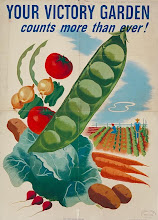
My green beans are ready for picking. In fact, I picked a bunch yesterday in the hot hot sun. Next year I think I'll plant yellow wax beans -- much easier to see amongst the green leaves and stems.

The sprouts are looking good. I think I will cut off the lower leaves, the worm-damaged ones. I've read that encourages sprout growth. I'm not sure if it's true (I am loath to prune vegetables, thinking that the plant must know what is best for itself), but the lower leaves are full of holes anyway, so it may be a good time to test the theory.

The sweet corn is loving the warmer weather. I've heard old-timer farmers say that you can almost watch the corn grow when the days get hot. I don't have any plans to test that theory.

My potatoes. So beautiful, so promising earlier this summer. I planted this large patch in the hopes of storing several hundred pounds of potatoes in my root cellar this fall. But, as you can see, I have a problem -- a problem called blight. When a few plants started turning yellow a couple of weeks ago, I thought nothing of it -- I thought they were just dying back naturally. I had no clue. Now half of my plants are afflicted.
I can try to save the tubers themselves by cutting the potato stems and burning them. The tubers, if not already infected, can set their skins while still in the soil, and I can harvest them later. But if they are infected, they will rot in storage. So I have a dilemma -- should I risk the rot and try to store the tubers, or should I try to salvage what I have and do a massive potato canning/freezing operation?
Blight is what caused the Irish Potato Famine of the 19th century. I guess I should be honored that such a historically significant disease has decided to invade my meager garden. It's a fungus that lives in the plant and in the soil, spread by infected seed or by spores in the wind. It is exacerbated by cool, wet weather followed by warm, dry weather. Guess what we've had this summer?
Blight will stay in the soil from one year to the next. This makes my rotational gardening plans even more attractive. You can control it somewhat by using fungicide throughout the growing season. But I don't want to do that.
If my tubers carry the rot, I won't be able to save potatoes for next year's planting. I need to do some research into blight-resistant potato varieties for next year.
And I need to put up some sort of blockade between my infected potatoes and my not-yet infected tomatoes. In one corner of my potato patch, some of my potatoes (non-blight ones, so far) have grown so huge (thanks, chicken litter) that they have flopped over the pathway between beds, brushing up against my tomato patch. If infected potatoes touch tomatoes, then the tomatoes will get it. The blight affects both vegetables, as they are from the same family. A sheet of plywood and a few cement blocks should do the trick. I hope. Or maybe I should just mow all the potatoes down now and hope for the best.
To end on a good note, here are a few of the apples on our tree. I've long ago forgotten what variety we planted here. I can't wait to cut one of these beauties open and taste it. If it's sweet, we'll use the apples for fresh eating. If it's tart, I'll use them for pies. Mmmm. Home-grown apple pie.


